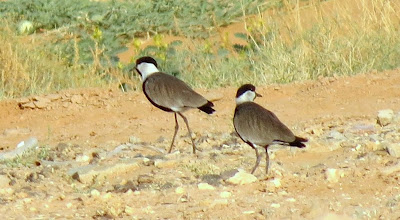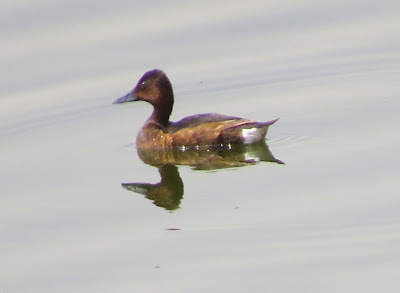spur winged lapwing
We got very mixed results. We chose to start at the east end of wadi Thulaymah. This wadi houses Kharj's waste water river like a mini version of Wadi Hanifah and Al Hayer near Riyadh. It used to end in a small lake system which was good for birds. However we discovered this has been land filled since our last visit.
spur winged lapwing in flight
Furthermore, when we found the end of the stream, although it looked really good for birds was a shooting alley for illegal hunters.
Despite this we found a decent sized flock of spur winged lapwing in the area and even better a large flock of chestnut bellied sandgrouse flew over. These birds used to drink regularly at roughly the same time most days at the lakes. It appears they still visit the area and have probably found a new drinking spot near-by.
If you haven't seen chestnut bellied sandgrouse, this is probably the best reason to go to Kharj.
The stream at the east end of Wadi Thulaymah
In the stream were two very jumpy green sandpiper and a single Temminck's stint. Understandably, they didn't allow close contact but I got a few record shots of the stint (not shown).
Namaqua dove
Other birds in this area were a little bittern, two squacco heron, many house sparrow, a marsh harrier, black bush robin, laughing dove, feral pigeon, collared dove and little green bee-eater.
Time is precious at this time of the year because it heats up rapidly. So we made the quick decision to rapidly tour further upstream and then to move back towards Riyadh down the Kharj road and try our luck at the lake near the cricket club.
On our way upstream we added black crowned night heron, Namaqua dove and Indian silverbill to our sightings. There were also some glimpses of some probable European reed warbler.
The reeds are very thick along much of the "river" and that can be quite frustrating.
Lake near the cricket club
The one similarity we found at the cricket club lake with Kharj was the nervousness of the birds. Though that might in part be due to the lack of any real cover for the bird watcher. I had to photograph from great distances but Lou's spotting scope was invaluable. These things apart, the birding was extremely good.
two glossy ibis
Before the car had even parked up, Lou spotted two glossy ibis overhead.
It was immediately obvious the lake had many tens of coot, moorhen and little grebe as usual.
Locally resident pale crag martin and passage barn swallow were hawking for insects overhead.
We didn't know what waders to expect as they come in waves and many pass through quickly at this time of year.
Kentish plover, black winged stilt and common sandpiper
Ruff and black winged stilt were the most numerous with several tens around. The latter is probably a breeder here. Smaller but still significant numbers of both common sandpiper and green sandpiper were present.
The related trio of Kentish plover, little ringed plover and ringed plover were seen. Spur winged lapwing is almost always seen when we visit and was here again.
More, unexpectedly a single grey plover was observed. They are rarely seen this far inland.
two common snipe
Lou first saw it and two common snipe near a large flock of ruff. These were my first snipe since the spring.
Common ringed plover and common snipe
Mallard are known residents here but today I didn't see any. I suspect they hid deep. We have also seen Ferruginous duck here in all seasons but not every time. The good news is that this was seen today. less commonly, five teal were also on the lake.
Ferruginous duck
I suspect the lake will be good for ducks this winter.
To finish the picture and name all the observed birds, graceful prinia and house sparrow were seen in and near the reeds. Little green bee-eater was common too.
The lake proved an excellent end to the morning after a slightly disappointing start.











No comments:
Post a Comment